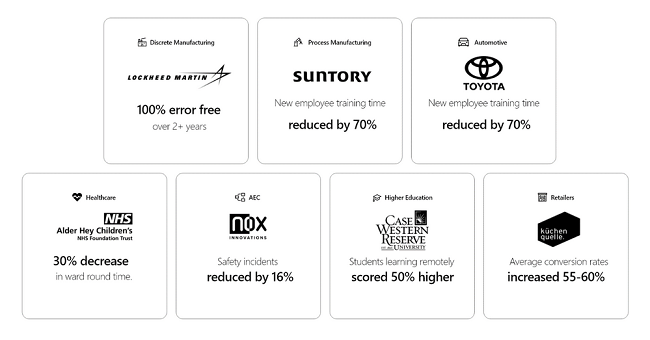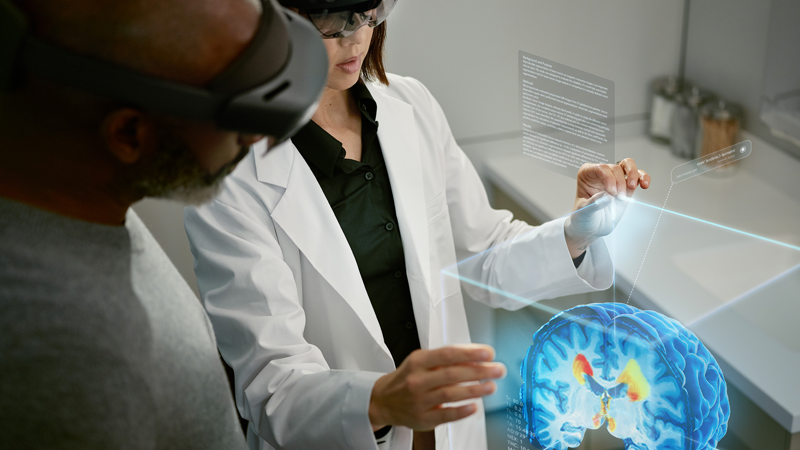What HoloLens can do
HoloLens is a mixed-reality device that's been successfully deployed in manufacturing, construction, retail, education, and healthcare industries. Organizations that have deployed HoloLens in those sectors have routinely realized record returns on their investment. When you learn what HoloLens can do, you'll realize that you can share their success.
HoloLens 2 return on investment
The Commissioned Forrester Consulting TEI study on HoloLens 21 estimates the following benefits to adopting HoloLens:
"An immense breadth of mixed reality use cases across industries and roles are possible with HoloLens 2, powered by a comprehensive ecosystem of applications and services from Microsoft and myriad third-party partners. Mixed reality on HoloLens 2 is broadly extensible; its support for custom code and cloud services has led to a growing market of customers and partners that continually expand the bounds of possibility."

More than half of the Fortune 500 enterprises have purchased Microsoft HoloLens 2.

HoloLens 2 solutions
For a technology manager designing your next product innovation, an IT professional considering your next device deployment, or a developer seeking to create a custom application for a known problem, there are many applications and use cases HoloLens supports.
Here are some application categories that might fit the needs of your organization:

- Design and prototyping: Visualizing prototypes holographically can reduce design and alteration costs.
- Training and development: HoloLens can assist with designing, developing, and deploying training and simulation experiences. With HoloLens 2, trainees can learn by doing from anywhere with holographic instructions.
- Geo-spatial planning: The human–computer physical interactions HoloLens makes possible provide ways for users to interact with virtual geographic scenes.
- Sales assistance: You can cut back on overhead costs at the same time you're increasing sales. HoloLens 2 augmented-reality solutions allow customers to fully visualize and fall in love with what they're buying before they buy it.
- Field service: Frontline workers using Dynamics 365 Remote Assist on HoloLens can see their Field Service bookings and quickly call the remote collaborator listed in the booking's Support Contact field.
- Productivity and collaboration: Collaborate without boundaries and act with precision to increase employee productivity with mixed-reality applications on HoloLens 2.
HoloLens deployments in key industries
HoloLens 2 was designed to provide business solutions by distributing software and services to multiple users in enterprise environments. A HoloLens deployment's size depends on the use case's scope and the business problem to be solved.
- Manufacturing: Reduce downtime and speed up onboarding and upskilling using HoloLens 2.
- Engineering and construction: Accelerate construction pace and mitigate risks earlier in the construction cycle using HoloLens 2.
- Healthcare: Enhance the patient-treatment delivery at the point of care using HoloLens 2.
- Education: Improve student outcomes and teach from anywhere with experiential learning using HoloLens 2.
Manufacturing organizations
Companies in the aerospace industry are using HoloLens 2 to design and prototype solutions to expedite aircraft design, facilitate collaboration, and accelerate production goals. Lockheed Martin is using HoloLens 2 to build the Orion Spacecraft. Over a two-year period, they've had zero human errors or rework requests in manufacturing and assembly.
Most manufacturers reduce human error by approximately 30% with HoloLens 2. Lockheed Martin has had an even greater return on investment. On one key component, the company saved $38 for each of the 57,000 fasteners in the spacecraft.
Engineering and construction
With Mixed Reality, architecture, engineering, and construction (AEC) firms are empowered to overcome design, modeling, collaboration, and building-site challenges to improve productivity and enhance project quality and decision-making. For example, AEC firms have reduced rework by 75%, saving $44 per hour1.
Common scenarios in which AEC organizations benefit from mixed reality on Microsoft HoloLens 2:
- Clash detection: Enable onsite workers to preemptively identify issues, detect clashes, and gain buy-in of onsite workers and key stakeholders with overlay designs on physical locations. This mitigates late-stage design changes that could result in rework, budget overrun, and project delays.
- 3D plan and model demonstrations: Empower project leaders, designers, and engineers and improve customer service and sales with 3D demonstrations and immersive visualizations. Self-guided learning: Equip onsite workers to view task instructions, essential data, and model visualizations while in the flow of work, thereby increasing speed, quality, and safety.
"HoloLens 2 provides an exponential increase in knowledge transfer compared to text or picture documentation. With the 3D interface, you can see a vehicle in the correct location and spatial orientation, and you can pull away or hide the parts you don’t need to see and tear down a virtual model of a car in a fraction of the time it would take with a real one." — Porsche. Read the full customer story2.
Healthcare organizations
Healthcare providers are faced with a unique challenge: the work itself is hands-on, but any training that takes place in an authentic environment runs the risk of adversely impacting patient care. Using HoloLens to train healthcare workers allows them to learn how to examine, diagnose, treat patients, and practice technical surgical skills in a low-risk simulated environment that's devoid of real-life consequences.
Mixed reality empowers providers, payors, and health-science experts to reimagine healthcare by accelerating diagnoses, reducing time to care, and enabling personalization. Using Microsoft mixed reality, healthcare providers reduced average consumables by 80%, saving $4,000 per trainee1.

Common scenarios in which healthcare providers benefit from mixed reality on Microsoft HoloLens 2:
- Holographic patient consultation: Enable healthcare providers to project 3D holographic visualizations of patients’ internal systems that provide procedural understanding, building confidence in upcoming procedures and/or treatments.
- Remote expert consultation: Support remote consultation and enable medical staff to consult colleagues heads-up and hands-free through an interactive collaborative experience from anywhere in the world.
- Training simulations: Train medical staff with holographic step-by-step guidance without subject matter experts being physically present.
"Using Dynamics 365 Remote Assist, doctors wearing HoloLens, can hold "hands-free" and "heads-up" Teams video calls with colleagues and experts anywhere in the world. They can receive advice, interacting with the caller and the patient at the same time, while medical notes and X-rays can also be placed alongside the call in the wearer’s field of view." — Imperial College Healthcare NHS Trust. Read more about the Imperial College Healthcare NHS Trust customer story3.
Education
Educators are turning to Microsoft HoloLens 2 and mixed-reality applications to help students embrace a new way of learning. For example, education institutions reduced 520 annual hours of instruction per expert by 15%1.
Common scenarios in which educators benefit from mixed reality on Microsoft HoloLens 2:
- Augmented teaching: Captivate students and bring education to life with high-impact 3D visualization models that enable virtual collaboration and instruction.
- Experiential learning: Enable educators to build an experience-based lesson plan, integrating textbook concepts into physical environments to create a simple "learn by doing" approach for students, hands-on and unmediated.
- Scaled learning and research: Develop a scalable research collaboration model that improves efficiency of research, lab work, and medical training.
"We did a trial back with our medical students. The students that had been in the HoloLens lab scored 50% better compared to the rest of the med school class." — Case Western. Read more about the Case Western customer story4.
Retail organizations
Retailers credit HoloLens for helping them gather and visualize information to gain deep insights on inventory and customer services that lead to better business decisions. Holographic simulations of real-life scenarios have helped employees of large retail chains to competently perform key tasks as soon as they step on the floor. In the retail industry, average conversion rate for HoloLens increased 55 to 60%5.
One retail chain partnered with Microsoft to use HoloLens 2 to create 3D models of reconfigured stores, training employees on restocking products, coupon redemptions, and unfamiliar customer-service situations. Some retailers reported that their customer service was poor until they deployed HoloLens and Dynamics 365.
References
1-5: See the Additional reading section in this module's Summary unit.